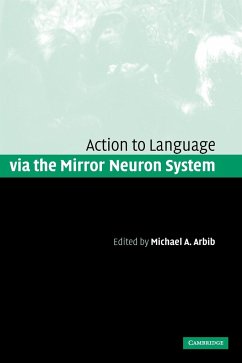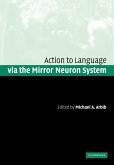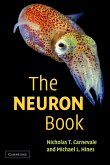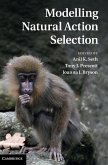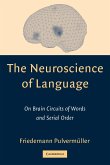- Gebundenes Buch
- Merkliste
- Auf die Merkliste
- Bewerten Bewerten
- Teilen
- Produkt teilen
- Produkterinnerung
- Produkterinnerung
Multidisciplinary 2006 book discussing the role of the evolutionary basis for the brain mechanisms that support language.
Andere Kunden interessierten sich auch für
![Action to Language Via the Mirror Neuron System Action to Language Via the Mirror Neuron System]() Action to Language Via the Mirror Neuron System75,99 €
Action to Language Via the Mirror Neuron System75,99 €![The Neuron Book The Neuron Book]() Nicholas T. CarnevaleThe Neuron Book91,99 €
Nicholas T. CarnevaleThe Neuron Book91,99 €![Modelling Natural Action Selection Modelling Natural Action Selection]() Modelling Natural Action Selection222,99 €
Modelling Natural Action Selection222,99 €![The Neuroscience of Language The Neuroscience of Language]() Friedemann PulvermullerThe Neuroscience of Language156,99 €
Friedemann PulvermullerThe Neuroscience of Language156,99 €![Mapping of Nervous System Diseases Via Micrornas Mapping of Nervous System Diseases Via Micrornas]() Mapping of Nervous System Diseases Via Micrornas205,99 €
Mapping of Nervous System Diseases Via Micrornas205,99 €![The Neuroscience of Language The Neuroscience of Language]() Friedemann PulvermullerThe Neuroscience of Language74,99 €
Friedemann PulvermullerThe Neuroscience of Language74,99 €![Mapping of Nervous System Diseases via MicroRNAs Mapping of Nervous System Diseases via MicroRNAs]() Mapping of Nervous System Diseases via MicroRNAs70,99 €
Mapping of Nervous System Diseases via MicroRNAs70,99 €-
-
-
Multidisciplinary 2006 book discussing the role of the evolutionary basis for the brain mechanisms that support language.
Produktdetails
- Produktdetails
- Verlag: Cambridge University Press
- Seitenzahl: 568
- Erscheinungstermin: 16. April 2015
- Englisch
- Abmessung: 260mm x 183mm x 35mm
- Gewicht: 1250g
- ISBN-13: 9780521847551
- ISBN-10: 0521847559
- Artikelnr.: 23185697
- Herstellerkennzeichnung
- Libri GmbH
- Europaallee 1
- 36244 Bad Hersfeld
- gpsr@libri.de
- Verlag: Cambridge University Press
- Seitenzahl: 568
- Erscheinungstermin: 16. April 2015
- Englisch
- Abmessung: 260mm x 183mm x 35mm
- Gewicht: 1250g
- ISBN-13: 9780521847551
- ISBN-10: 0521847559
- Artikelnr.: 23185697
- Herstellerkennzeichnung
- Libri GmbH
- Europaallee 1
- 36244 Bad Hersfeld
- gpsr@libri.de
Michael A. Arbib is the Fletcher Jones Professor of Computer Science, as well as a Professor of Biological Sciences, Biomedical Engineering, Electrical Engineering, Neuroscience and Psychology at the University of Southern California (USC), which he joined in 1986. He has been named as one of a small group of university professors at USC in recognition of his contributions across many disciplines.
Preface; Part I. Two Perspectives: 1. The mirror system hypothesis on the
linkage of action and languages Michael Arbib; 2. The origin and evolution
of language: a plausible, strong-AI account Jerry Hobbs; Part II. Brain,
Evolution and Comparative Analysis: 3. Cognition, imitation and culture in
the great apes Craig Stanford; 4. The signer as an embodied mirror neuron:
neural systems underlying sign language and action Karen Emmorey; 5. Neural
homologies and the grounding of neurolinguistics Michael Arbib and Mihail
Bota; Part III. Dynamical Systems in Action and Language: 6. Dynamical
systems: brain, body and imitation Stefan Schaal; 7. The role of vocal
tract gestural action units in understanding the evolution of phonology
Louis Goldstein, Dani Byrd and Elliot Saltzman; 8. Lending a helping hand
to hearing: a motor theory of speech perception Jeremy I. Skipper, Howard
C. Nusbaum and Steven L. Small; Part IV. From Mirror System to Syntax and
Theory of Mind: 9. Attention and the minimal subscene Laurent Itti and
Michael Arbib; 10. Action verbs, argument structure constructions, and the
mirror neuron system David Kemmerer; 11. Linguistic corpora and theory of
mind Andrew Gordon; Part V. Development of Action and Language: 12. The
development of grasping and the mirror system Erhan Oztop, Nina Bradley and
Michael Arbib; 13. Development of goal-directed imitation, object
manipulation and language in humans and robots Iona D. Goga and Aude
Billard; 14. Affordances, effectivities and the mirror system in child
development Patricia Zukow-Goldring; 15. Implications of mirror neurons for
the ontogeny and phylogeny of cultural processes: the examples of tools and
language Patricia Greenfield.
linkage of action and languages Michael Arbib; 2. The origin and evolution
of language: a plausible, strong-AI account Jerry Hobbs; Part II. Brain,
Evolution and Comparative Analysis: 3. Cognition, imitation and culture in
the great apes Craig Stanford; 4. The signer as an embodied mirror neuron:
neural systems underlying sign language and action Karen Emmorey; 5. Neural
homologies and the grounding of neurolinguistics Michael Arbib and Mihail
Bota; Part III. Dynamical Systems in Action and Language: 6. Dynamical
systems: brain, body and imitation Stefan Schaal; 7. The role of vocal
tract gestural action units in understanding the evolution of phonology
Louis Goldstein, Dani Byrd and Elliot Saltzman; 8. Lending a helping hand
to hearing: a motor theory of speech perception Jeremy I. Skipper, Howard
C. Nusbaum and Steven L. Small; Part IV. From Mirror System to Syntax and
Theory of Mind: 9. Attention and the minimal subscene Laurent Itti and
Michael Arbib; 10. Action verbs, argument structure constructions, and the
mirror neuron system David Kemmerer; 11. Linguistic corpora and theory of
mind Andrew Gordon; Part V. Development of Action and Language: 12. The
development of grasping and the mirror system Erhan Oztop, Nina Bradley and
Michael Arbib; 13. Development of goal-directed imitation, object
manipulation and language in humans and robots Iona D. Goga and Aude
Billard; 14. Affordances, effectivities and the mirror system in child
development Patricia Zukow-Goldring; 15. Implications of mirror neurons for
the ontogeny and phylogeny of cultural processes: the examples of tools and
language Patricia Greenfield.
Preface; Part I. Two Perspectives: 1. The mirror system hypothesis on the
linkage of action and languages Michael Arbib; 2. The origin and evolution
of language: a plausible, strong-AI account Jerry Hobbs; Part II. Brain,
Evolution and Comparative Analysis: 3. Cognition, imitation and culture in
the great apes Craig Stanford; 4. The signer as an embodied mirror neuron:
neural systems underlying sign language and action Karen Emmorey; 5. Neural
homologies and the grounding of neurolinguistics Michael Arbib and Mihail
Bota; Part III. Dynamical Systems in Action and Language: 6. Dynamical
systems: brain, body and imitation Stefan Schaal; 7. The role of vocal
tract gestural action units in understanding the evolution of phonology
Louis Goldstein, Dani Byrd and Elliot Saltzman; 8. Lending a helping hand
to hearing: a motor theory of speech perception Jeremy I. Skipper, Howard
C. Nusbaum and Steven L. Small; Part IV. From Mirror System to Syntax and
Theory of Mind: 9. Attention and the minimal subscene Laurent Itti and
Michael Arbib; 10. Action verbs, argument structure constructions, and the
mirror neuron system David Kemmerer; 11. Linguistic corpora and theory of
mind Andrew Gordon; Part V. Development of Action and Language: 12. The
development of grasping and the mirror system Erhan Oztop, Nina Bradley and
Michael Arbib; 13. Development of goal-directed imitation, object
manipulation and language in humans and robots Iona D. Goga and Aude
Billard; 14. Affordances, effectivities and the mirror system in child
development Patricia Zukow-Goldring; 15. Implications of mirror neurons for
the ontogeny and phylogeny of cultural processes: the examples of tools and
language Patricia Greenfield.
linkage of action and languages Michael Arbib; 2. The origin and evolution
of language: a plausible, strong-AI account Jerry Hobbs; Part II. Brain,
Evolution and Comparative Analysis: 3. Cognition, imitation and culture in
the great apes Craig Stanford; 4. The signer as an embodied mirror neuron:
neural systems underlying sign language and action Karen Emmorey; 5. Neural
homologies and the grounding of neurolinguistics Michael Arbib and Mihail
Bota; Part III. Dynamical Systems in Action and Language: 6. Dynamical
systems: brain, body and imitation Stefan Schaal; 7. The role of vocal
tract gestural action units in understanding the evolution of phonology
Louis Goldstein, Dani Byrd and Elliot Saltzman; 8. Lending a helping hand
to hearing: a motor theory of speech perception Jeremy I. Skipper, Howard
C. Nusbaum and Steven L. Small; Part IV. From Mirror System to Syntax and
Theory of Mind: 9. Attention and the minimal subscene Laurent Itti and
Michael Arbib; 10. Action verbs, argument structure constructions, and the
mirror neuron system David Kemmerer; 11. Linguistic corpora and theory of
mind Andrew Gordon; Part V. Development of Action and Language: 12. The
development of grasping and the mirror system Erhan Oztop, Nina Bradley and
Michael Arbib; 13. Development of goal-directed imitation, object
manipulation and language in humans and robots Iona D. Goga and Aude
Billard; 14. Affordances, effectivities and the mirror system in child
development Patricia Zukow-Goldring; 15. Implications of mirror neurons for
the ontogeny and phylogeny of cultural processes: the examples of tools and
language Patricia Greenfield.

